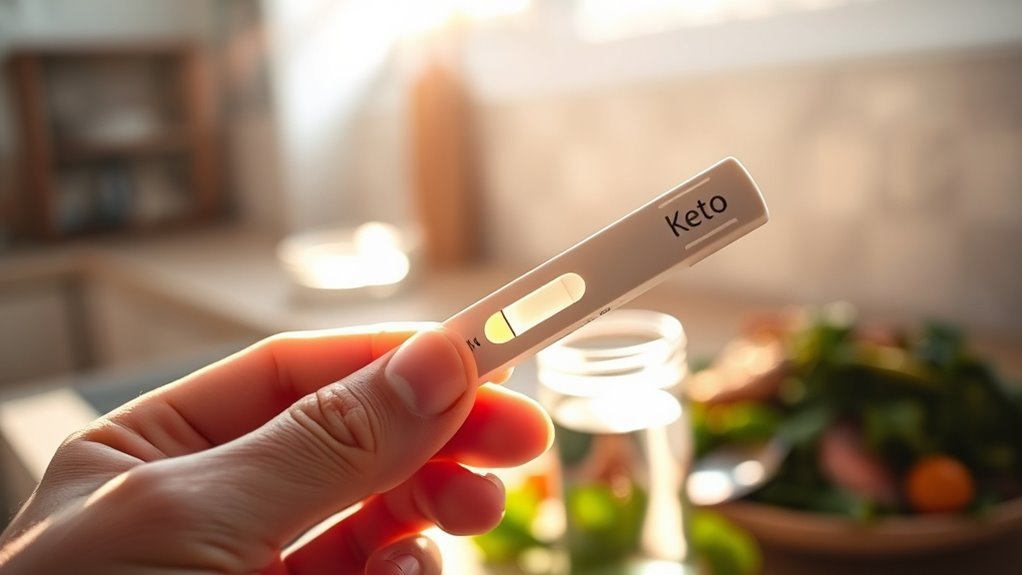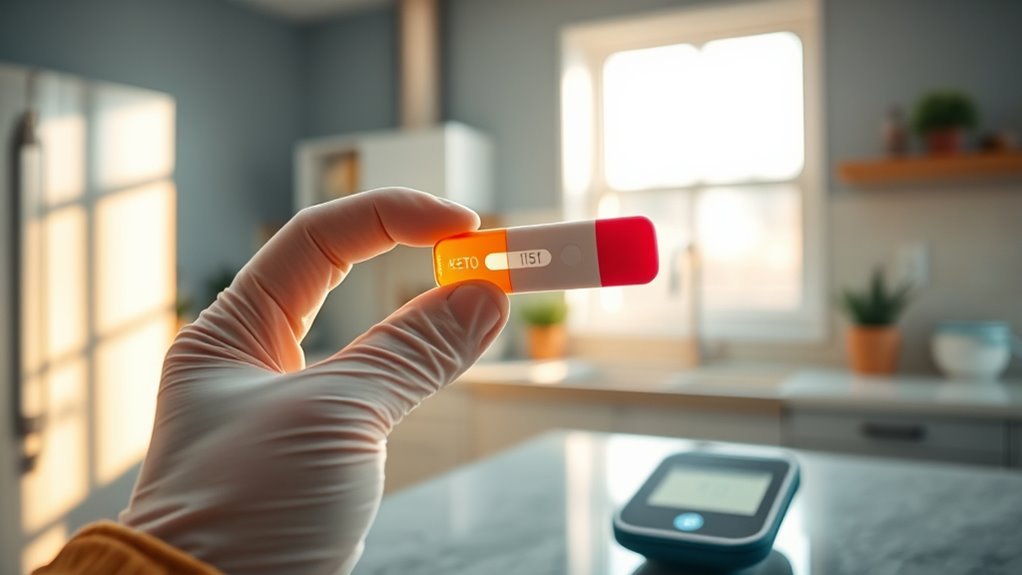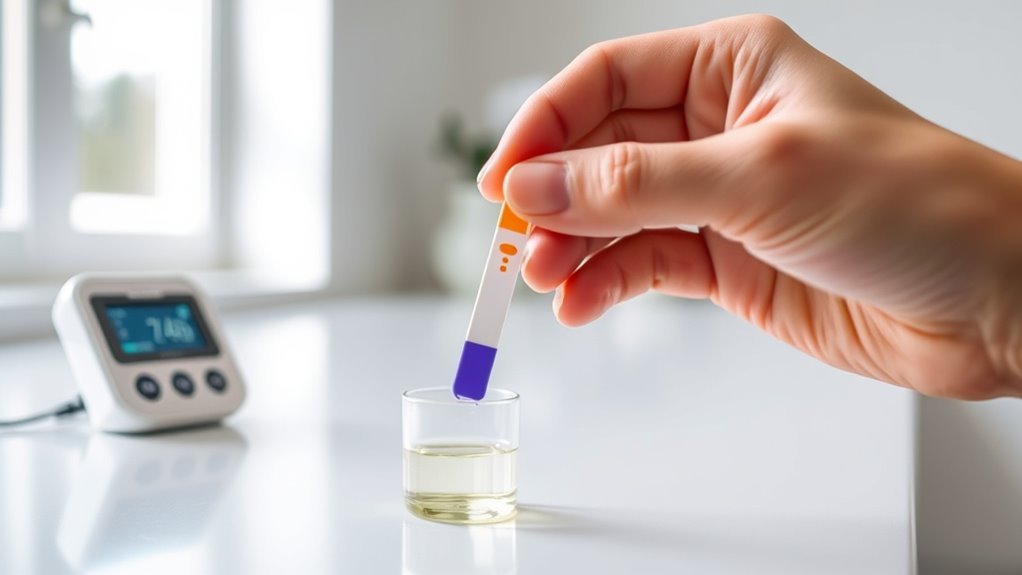To use a keto test strip, first verify you’re following a ketogenic diet and stay hydrated. In the morning or 30 minutes post-workout, collect a urine sample and dip the strip in it for a few seconds. Compare the color change to the provided chart to determine your ketone levels. Factors like hydration can affect accuracy, so test consistently. If you want to optimize your results, there’s more valuable information to reflect on.
What Are Keto Test Strips?

Keto test strips are simple, at-home tools designed to measure the level of ketones in your urine, providing insight into whether you’re in a state of ketosis. When you’re following a keto diet, your body shifts from burning carbohydrates to burning fat for energy, producing ketone bodies as a byproduct. These strips allow you to easily track your progress and confirm if your body is effectively utilizing fat for fuel. By dipping a strip into your urine, you can visually assess the color change, which indicates the concentration of ketones present. This quick feedback empowers you to adjust your dietary choices, ensuring you stay on the right path to achieve your health and wellness goals.
How Do Keto Test Strips Work?

Keto test strips work by detecting ketones in your urine, specifically acetoacetate, which is a byproduct of fat metabolism. When you use a strip, it changes color based on the concentration of ketones present, allowing you to gauge your body’s state of ketosis. Understanding these color changes can help you interpret whether you’re effectively following a ketogenic diet.
Understanding Ketone Detection
When you’re on a low-carb diet, tracking your ketone levels becomes essential for understanding your body’s state of ketosis. Keto test strips detect ketone bodies in your urine, providing a simple way to gauge your metabolic state. When your body shifts to burning fat for fuel, it produces ketones, which these strips measure.
| Ketone Level | Metabolic State |
|---|---|
| Low (0.5 mmol/L) | Not in ketosis |
| Moderate (1-3 mmol/L) | In ketosis |
| High (3+ mmol/L) | Deep ketosis |
Interpreting Color Changes
Understanding how to interpret color changes on keto test strips is key to effectively monitoring your ketone levels. These strips provide a visual representation of your body’s ketosis status, allowing you to make informed dietary choices. The color meanings indicate different levels of ketones, which can guide your progress.
- Light Pink: Low ketone levels, indicating you may need to increase your fat intake.
- Dark Pink: Moderate levels, suggesting you’re in a mild state of ketosis.
- Purple: High levels, meaning you’re likely in deep ketosis, which can enhance fat burning.
Recognizing the color significance helps you adjust your lifestyle and stay aligned with your health goals, giving you the freedom to optimize your keto journey.
When to Use Keto Test Strips

Using keto test strips can be particularly beneficial during specific stages of your ketogenic journey. The best times to use them are typically in the morning, right after waking up, or about 30 minutes after a workout. These moments provide a clear snapshot of your ketone levels, helping you gauge how well your body is adapting to ketosis. Additionally, you might want to measure ketones after adjusting your diet or introducing new foods, as this can affect your state of ketosis. Regular testing can empower you to make informed decisions about your diet, ensuring you maintain the freedom to enjoy your keto lifestyle while staying on track with your health goals.
Steps to Using a Keto Test Strip
To effectively use a keto test strip, you’ll need to follow a few key steps. Start by preparing for the test to guarantee accurate results, then move on to the testing procedure itself. Finally, you’ll interpret the results to understand your ketone levels and adjust your diet as needed.
Preparing for the Test
Before you plunge into testing your ketone levels, it’s essential to guarantee you’re adequately prepared. Proper test strip preparation can make a significant difference in the accuracy of your results. Here are three key steps to make sure you’re ready:
- Check the Expiry Date: Make certain your keto test strips are within their expiration date for reliable results.
- Stay Hydrated: Drink enough water prior to testing, as dehydration can affect ketone concentration.
- Follow the Keto Diet Essentials: Stick to your keto diet plan consistently before testing, as this will help you achieve and maintain ketosis.
Testing Procedure Explained
Testing your ketone levels with a keto test strip involves a straightforward process that can be completed in just a few steps. First, verify your strips are stored in a cool, dry place to maintain testing accuracy. Next, collect a urine sample in a clean container. Dip the strip into the urine for a couple of seconds, then remove it and let it sit for the time specified on the package.
Here’s a quick reference table for your testing process:
| Step | Action |
|---|---|
| 1. Strip Storage | Keep in a cool, dry place |
| 2. Sample Collection | Use a clean container |
| 3. Dip and Wait | Dip strip, then wait as instructed |
Following these steps guarantees accurate results.
Interpreting the Results
How can you make sense of the results from your keto test strip? Understanding your keto results involves interpreting the color change on the strip, which indicates the level of ketones in your body. Here’s how to assess your results effectively:
- Color Scale: Compare the strip to the color chart provided with your test kit. This helps you gauge your level of ketosis—whether you’re in light, moderate, or deep ketosis.
- Timing of Test: For accurate testing, check your ketone levels at the same time daily, ideally after fasting. This consistency improves testing accuracy.
- Dietary Adjustments: If your results aren’t what you hoped, consider adjusting your carb intake or meal timing to enhance ketosis.
Understanding the Color Chart
A clear understanding of the color chart on your keto test strip is essential for accurately interpreting your results. Each color variation on the strip corresponds to specific levels of ketones in your urine, indicating how well your body is entering ketosis. Typically, you’ll see a range from light pink to deep purple. Light colors suggest low ketone levels, while darker shades signify higher concentrations. Familiarizing yourself with these color meanings helps you gauge your progress on the keto diet. Remember, the goal is to achieve a medium to high level of ketones, often represented by a darker hue. Knowing this can empower you to adjust your dietary choices for best results in your ketogenic journey.
Factors That Can Affect Your Readings
While you’re monitoring your ketone levels, several factors can influence the accuracy of your readings. Understanding these can help you interpret your results more effectively. Here are three key factors to take into account:
- Dietary Changes: Sudden shifts in your eating habits can impact ketone production. If you’ve recently altered your carb intake or fat consumption, it may take time for your body to adjust.
- Hydration Levels: Dehydration can lead to concentrated urine, potentially skewing your test results. Staying well-hydrated guarantees more accurate readings.
- Testing Time: The time of day you test can affect your readings. Ketone levels fluctuate throughout the day, so consistency is key for tracking progress.
Tips for Accurate Results
To guarantee you’re getting the most accurate results from your keto test strips, it’s crucial to follow some best practices. First, make certain you’re testing under consistent conditions; doing so helps eliminate variables that could skew your results. Aim to test at the same time each day, preferably after fasting overnight. Second, ensure your hands are clean and dry before handling the strips to avoid contamination. Third, check the expiration date on your strips, as expired products can lead to inaccurate readings. Finally, store your strips in a cool, dry place away from direct sunlight. By following these accuracy tips and maintaining ideal test conditions, you’ll increase the reliability of your keto test strip results.
Interpreting Your Results
Interpreting the results from your keto test strips is essential for understanding your body’s state of ketosis. These strips measure the ketone levels in your urine, giving you insight into how well your keto diet is working. Here’s how to interpret your results:
- Negative (0.0 – 0.5 mmol/L): You’re not in ketosis yet; consider adjusting your carb intake.
- Moderate (0.6 – 1.5 mmol/L): You’re in a mild to moderate metabolic state of ketosis, which is typically effective for weight loss.
- High (1.6 – 3.0 mmol/L): You’re in a strong state of ketosis; this can be beneficial for fat burning, but monitor for any adverse effects.
Understanding these levels can empower you to make informed decisions on your keto journey.
Alternatives to Keto Test Strips
If you’re looking for alternative ways to monitor your ketosis beyond keto test strips, there are several options available that can provide more extensive insights into your metabolic state. One popular choice is blood ketone monitors, which measure beta-hydroxybutyrate levels directly from a blood sample. This method offers high accuracy and is often favored by those wanting precise measurements. Additionally, you might consider keto breathalyzer options that analyze acetone levels in your breath, giving you a non-invasive way to gauge ketosis. Both methods can help you understand your body’s response to the ketogenic diet better, offering you the freedom to make informed adjustments while staying aligned with your health goals.
Frequently Asked Questions
Can I Reuse a Keto Test Strip?
You shouldn’t reuse a keto test strip. Each strip is designed for single use to guarantee accurate results. Reusing them compromises test strip hygiene, leading to potential contamination and unreliable readings. Additionally, the longevity of a test strip decreases considerably if it’s exposed to moisture or other substances after use. For the best results, always use a fresh strip to monitor your ketone levels accurately and maintain your health goals.
Are There Expiration Dates on Keto Test Strips?
Yes, keto test strips do have expiration dates. It’s essential to check the packaging for this information, as expired strips can compromise test strip accuracy. Proper keto test strip storage also plays a role; keep them in a cool, dry place, away from direct sunlight. Using expired or improperly stored strips may lead to unreliable results, so always verify you’re using fresh, correctly stored strips for the most accurate readings.
Do Keto Test Strips Measure Blood Ketones?
Keto test strips don’t measure blood ketones; they measure ketones in urine. While they can give you an idea about your keto diet effectiveness, they aren’t as precise as blood ketone measurement methods. If you want the most accurate readings to track your ketosis, consider using a blood meter instead. It provides a clearer picture of your metabolic state, giving you the freedom to adjust your diet for best results.
Can I Use Expired Keto Test Strips?
Using expired keto test strips isn’t advisable. Their effectiveness can diminish over time, meaning you might not get accurate readings. Safety-wise, while expired strips aren’t typically harmful, the results might mislead you about your ketone levels, impacting your keto journey. For reliable results, it’s best to use strips within their expiration date. Staying informed guarantees you’re empowered to make the best choices for your health and goals.
What Is the Cost Range for Keto Test Strips?
Keto test strip prices typically range from $10 to $30 for a pack, depending on the brand and quantity. If you’re looking for a buying guide, consider factors like accuracy, ease of use, and reviews. Some brands might offer bulk discounts, so it’s worth comparing options. Remember, investing in quality strips can help you track your keto progress more effectively, giving you the freedom to adjust your diet as needed.


